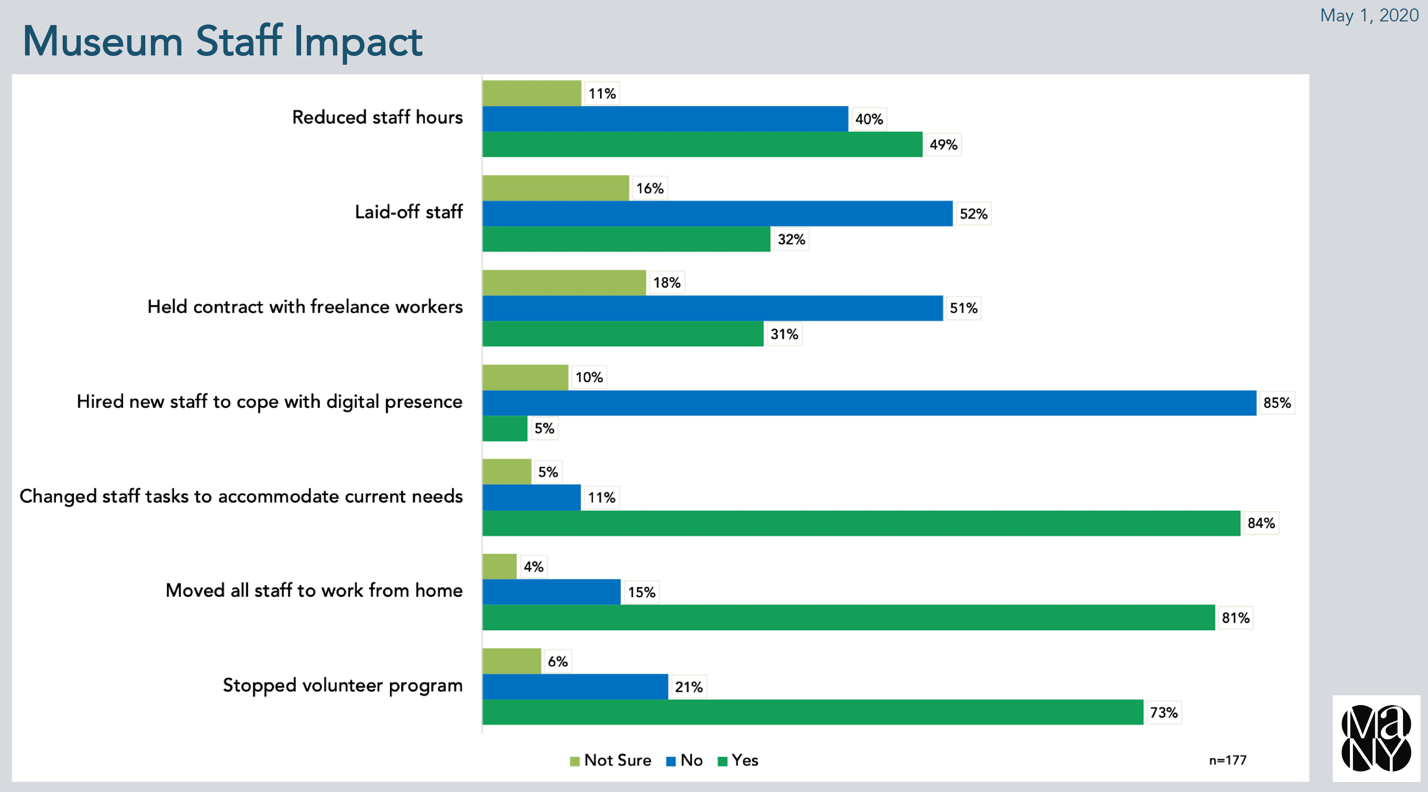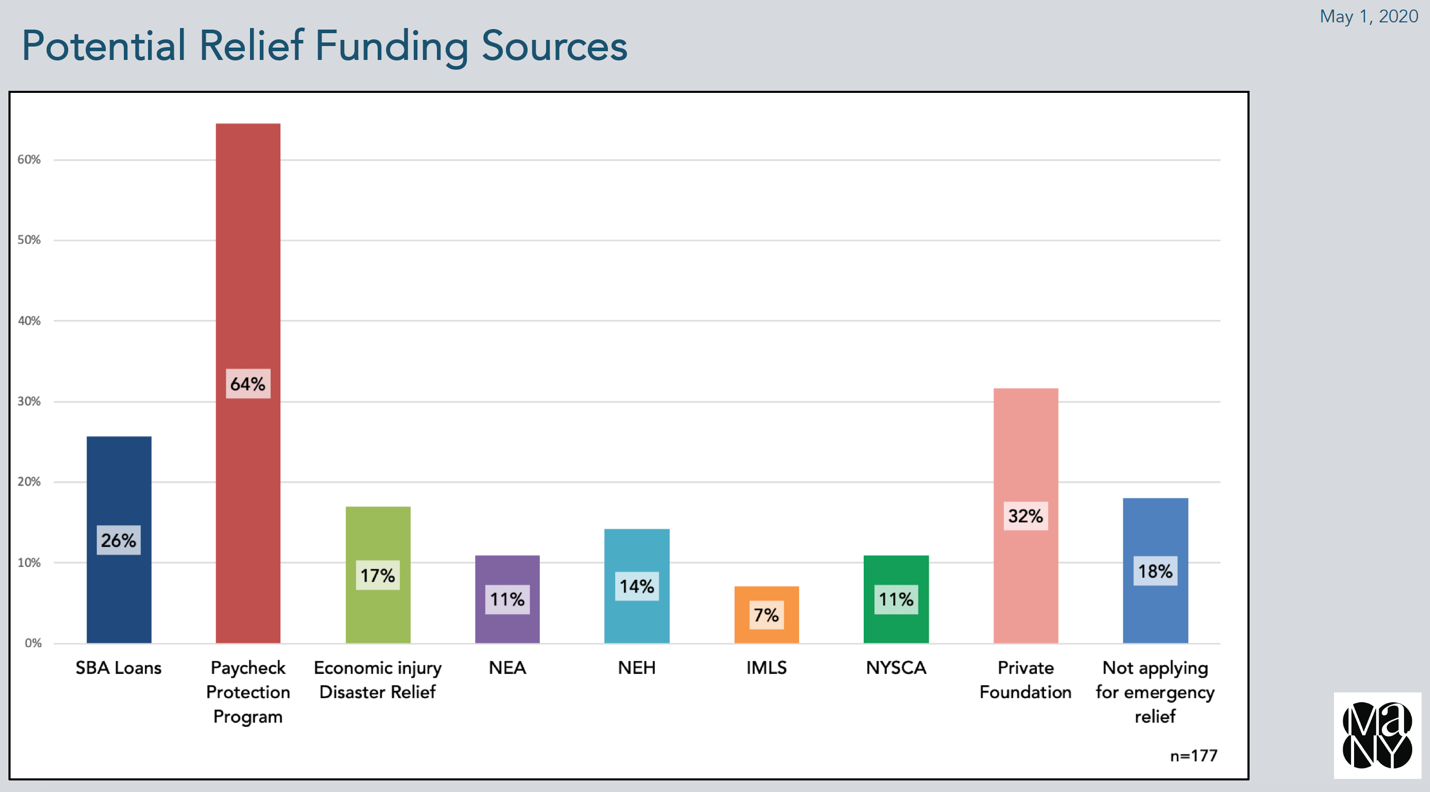
On October 21, 2020, MANY’s Executive Director, Erika Sanger testified at a roundtable presented by the New York State Senator José M. Serrano about the Impact on COVID-19 on our state’s arts and cultural institutions. The roundtable gave the arts and cultural community the opportunity to highlight the important contributions that cultural organizations make to New York’s economy and how those contributions have been impacted by the Covid-19 pandemic. The committee is accepting written testimony through November 11. Please take a moment to let the NY State Senate’s Cultural Affairs, Tourism, Parks and Recreation committee know how your museum has been affected by the pandemic. Send your testimony to serrano@nysenate.gov.
If you missed the Roundtable you can watch it here: https://www.nysenate.gov/calendar/events/cultural-affairs-tourism-parks-and-recreation/october-21-2020/arts-culture
Erika’s comments and slides appear below. On the recording, her remarks start at 1 hour/12 minutes, after the Bronx Zookeeper talks about the Sloth.
I am Erika Sanger, Executive Director of the Museum Association of New York. We help train museum professionals and offer museums a platform to amplify their messages, exchange information, and learn from one another across disciplines, budget sizes, and geographic locations. We conduct research and issue reports that paint accurate pictures of our sector and advocate for museums on the state and national level.

I am going to be sharing information we have been gathering over the past year that is available as downloadable pdfs from our website. These are the most visited pages on the site as we have become a “go to” resource for information about museums and Covid-19.

One of the first questions that is important for us to consider is “Why were museums in such a vulnerable position when Governor Cuomo declared NY on Pause by Executive Order on March 20, 2020?”
A third of the museums that responded to our 2019 State of NY State Museums survey ended 2018 in a deficit position. Most museums earn two thirds of their income from admissions, special events, and retail sales. When museums closed their doors, that income was lost overnight with no way to compensate.
The deficit positions in which many museums operate created situations in which part-time staff salaries were tied to earned income. Before COVID–19, in museums with budget sizes under $499,999, part time staff outnumbered full time staff by almost 2:1. At museums with budget sizes over $500,00 there was an almost equal ratio of part time to full time employees.
There will be more about staff impact later in this testimony. The next survey we conduct in early 2021 will help reveal how the pandemic has altered staff compositions structurally.

Historically, and pre-pandemic, museums were heavily dependent on private funding. Less than half were getting funding from the state and only one in five received federal funding. Corporate support is quickly approaching state support as a keystone of a museum’s financial profile.

The American Alliance of Museums estimates that museums are losing $33M a day because of closures in response to the COVID-19 Pandemic. At the height of the pandemic, New York’s museums were losing $3.5M a day. New York’s loss is 10% of the total loss of our nation’s museum community. This chart represents weekly loss by average amount lost. The Southern Tier region most closely parallels the statewide data, where NYC data shows the greatest losses. Note that we needed to change the scale on the “y” axis to accommodate scope of loss in NYC.

We know that some museums quickly responded to the pandemic with staff lay-offs and reductions in hours. Education and Visitor Services staff were particularly hard hit by furloughs and lay-offs. As a field, we have lost the most racially and culturally diverse, digitally knowledgeable generation to enter the museum sector.
We also know that many museums worked very hard to find solutions to keep staff employed by changing tasks and ensuring their safety by finding ways for them to work from home. Museums also took the necessary steps to help protect our vulnerable elders by suspending volunteer programs.

Despite the best efforts of New York State’s Congressional Delegation, the Federal response for funding opportunities available to New York’s museums was disproportionate and inadequate. Federal funds allocated in the CARES Act went to states and museums that never “closed.” To speed the distribution process, the NEA and NYSCA restricted funding to museums who were successful in obtaining grants in prior years. $30M of the $50M of Institute Museum and Library Services funds were immediately set aside for libraries. In April, $1.75M was allocated to the NYS library who announced just last week that they will soon share an application and distribution plan.
Despite those obstacles, more than two thirds of the museums who responded to the survey held out hope for government support.

We are all grateful for assistance from all of our funders, but we know that some emergency funding programs were more successful than others in meeting the immediate needs of the field. The Payroll Protection Program was confusing, difficult to access, and did not serve the field beyond mid-July, before many of NY’s Museums were even allowed to open to the public.

The largest amount of funding was sought to cover staff salaries to keep museum professionals employed and serving their communities. NY State has generously funded Capital Improvement Grants across the state investing millions of dollars in the restoration and improvement of museum facilities in the past ten years. However, state funding for programs and general operating support has never recovered from the 2008-09 reduction levels, leaving museum staff in a precarious position when the pandemic struck.

Actual distribution of relief funding was disproportionate to the tremendous need of the arts and cultural community and museums in NY.
$165 M of CARES ACT funding was distributed through the NEH, NEA, and the IMLS. $6 M or 3.5% of that funding went to NY’s museums who experienced 10% of the negative economic impact of the pandemic on our nation’s museum community.
The chart does not include second round of IMLS Cares Act funding which hadn’t announced at time we published this report.
The PPP served largest number of museums, the EIDL reached one in five, and private foundations reached one in four museums.

A deeper dive into the PPP reveals further inequities in relief funding distribution. 81,075 loans were made to businesses in NY. 142 of those went to museums; 76 were $150,000 or more and 66 were under $150,000. 7,062 Museum Jobs in New York were protected, 5338 of those were in NYC.

We collected data for the estimated reopening timeline in August and at that time, no one anticipated delaying their opening past September. As we know, reopening guidelines shifted and now many of our state’s museums are not scheduled to reopen until the spring of 2021.

Many of you who are following these issues closely have heard of the American Alliance of Museum’s recent national survey. One of the questions they asked was if museums believed they were at risk of closure in the next 16 months absent additional financial relief. The national response was 16% felt they are at risk of closure; in NY we are at 23%.
How can NY State help museums?
Extend attendance capacity beyond 25% as soon as it is safe to do so. Museums were already one of the cleanest indoor public building environments to maintain the safety of our collections. With COVID-19 compliant safety measures in place, such as increased cleaning, upgrades to air filtration systems, hand sanitizer stations, temperature checks, mask requirements, and contact tracing, museums are now among the safest indoor spaces.
New York could also provide critically needed additional funding to support museums that pre-pandemic employed 60,000 New Yorkers and had a $5.4B impact on our state’s economy.

What is MANY doing to help?
We are honored to receive $498,407 IMLS CARES Act Grant that will help us support 100 museums across NY State with hardware, software, and training to develop virtual programs. Thank you for listening.

